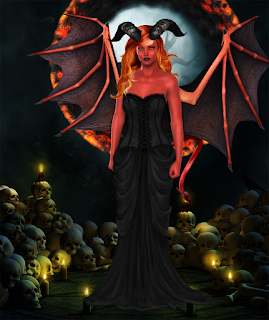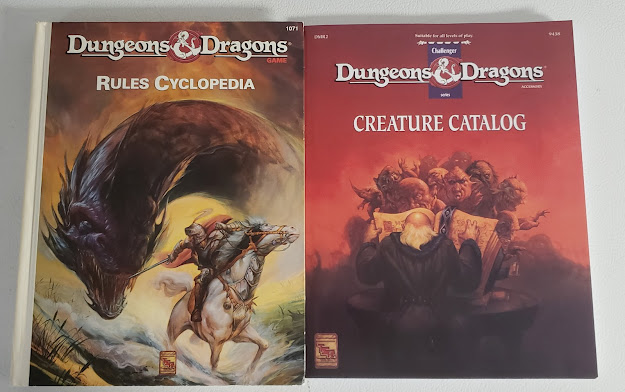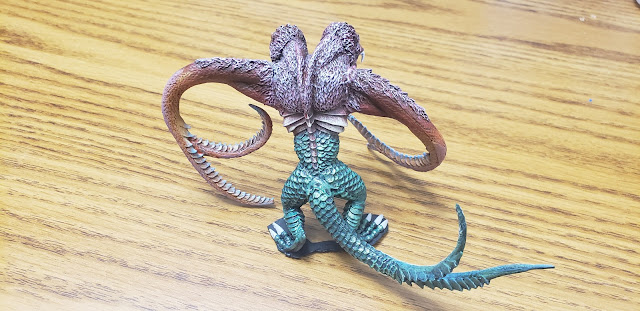One Man's God: Central American Mythos
I return to One Man's God today with one of my favorite groups of Mythos, and the one that is the most problematic in terms of dealing with real-world history and myths.
Central American Mythos is a catch-all section that includes gods and monsters from a variety of societies and times.
Olmec: 1500 BCE to about 400 BCE, Mexico
Maya: 2000 BCE to 1697 CE, southeastern Mexico (Yucatan), all of Guatemala and Belize, and the western portions of Honduras and El Salvador.
Mezcala: 700 BCE to 650 CE, Central Mexico.
Zapotec: 700 BCE to 1521 CE, Central/South Central Mexico.
Toltec: 900 CE to 1168 CE, Central Mexico. (and there is still debate on this)
Aztec: 1300 CE to 1521 CE, Central Mexico.
While these people and civilizations overlapped and had influences on each other, there are a number of distinct differences.
Another issue to deal with here is the nature of demons and the gods of these myths. In a very real sense, these myths are the epitome of "One Man's God is Another Man's Demon."
Even according to scholars it is difficult to tell what is a demon and what is a god. From the outsider's point of view, many of the Aztec and Mayan gods can be considered "Demonic" and were certainly called that by the Catholic Priests that would come to these lands from Spain (predominantly).
A good example are the Aztec
Tzitzimitl, or demons (or gods) from the stars. They were thought to have been the demons that attack the sun during a solar eclipse and also been the gods that protected to place where humans were created.
Tzitzimitl
Undead Demon
FREQUENCY: Very Rare
NO. APPEARING: 1-6
ARMOR CLASS: 3
MOVE: 12" Fly 24"
HIT DICE: 9+9 (50 hp)
% IN LAIR: 10%
TREASURE TYPE: Nil
NO. OF ATTACKS: 3 or 1
DAMAGE/ATTACK: 1-6 (claw)/1-6 (claw)/2-12 (bite) or bone club (1-10) + Special
SPECIAL ATTACKS: Cause Darkness
SPECIAL DEFENSES: +1 or better weapon to hit; double damage from sunlight
MAGIC RESISTANCE: 25%
INTELLIGENCE: Average
ALIGNMENT: Chaotic Evil
SIZE: L (9')
PSIONIC ABILITY: Nil
Tzitzimitl are the demonic spirits of women who have died in child-birth or stillborn babies. They appear as giant skeletal women wearing skirts decorated with the skulls and bones of their enemies. Around their necks, they wear the still-beating hearts of these enemies. They are charged with protecting the lands where humans were created and thus they are invoked by a Curandero when a woman is giving birth. They protect the mother and the child but demand that the ones that die be turned over to them.
They have been known to attack the sun during eclipses and this the time when they manifest in the Prime Plane.
They attack with a claw-claw-bite routine or with a legbone from a defeated enemy. On any successful hit with this leg bone, the victim must save vs. Paralysis or be blinded.
These creatures are semi-undead and can be turned by a cleric as
Special.
One god in the book that works very well as a demon is Camazotz, the God of Bats.
His name means "Death Bat" and as I have pointed out before he could be a God, a demon or even a very, very powerful vampire. In the Popol Vuh his description is very much demon-like.
Demon Lord, Camazotz
The Death Bat, Bat God, Sudden Bloodletter, Slaughter Lord
FREQUENCY: Unique
NO. APPEARING: 1
ARMOR CLASS: -2
MOVE: 12" Fly 24" (infinite at night)
HIT DICE: 24+24 (132 hp)
% IN LAIR: 10%
TREASURE TYPE: Qx10
NO. OF ATTACKS: 3
DAMAGE/ATTACK: 1-8 (claw)/1-8 (claw)/1-12 (bite) + Special, Blood Drain 3 Points of Con
SPECIAL ATTACKS: Cause Darkness, See in Darkness
SPECIAL DEFENSES: +2 or better weapon to hit; see below
MAGIC RESISTANCE: 50%
INTELLIGENCE: Genius
ALIGNMENT: Chaotic Evil
SIZE: L (15')
PSIONIC ABILITY: Nil
Camazotz is the demon god of bats and vampires. But he is not truly a god or a demon or a vampire but something that is thousands of years old and akin to all three. Vampires pay him homage more out of fear than actual piety. Humans on the other hand worship and hope that he will reward them with the gift of immortality (vampirism). He requires blood sacrifices every new moon. Camazotz himself goes through periods of extreme torpor and frenzied blood lust.
Camazotz dreams of one day destroying the god of the sun.
Camazotz attacks as a vampire with a claw/claw/bite routine of 1d8/1d18/1d12. His bite (any natural roll of 18, 19 or 20) will drain 3 points of Constitution per round. Anyone reduced to 0 becomes a vampire under his control.
He can see perfectly well in even the most complete of darkness, magical or mundane. He can also cause darkness as per the spell to 100’. In darkness his AC is reduced to -4 and +4 or better weapons are needed to strike him.
He lives in a dark cave-like plane know as Xibalba on the Abyss where he serves as a vassal to Orcus. Again this is not out of fidelity but out of fear of the Demon Prince of Undead. The cave is dark and the floors are stained with blood. In this cave, Camazotz can summon up to 1000 bats to do his will.
Camazozt appears as a giant bat whose mouth is filled with bloody fangs. He can also appear as an old man or a young warrior with bat wings.
He also makes a great demon lord to the Nabassu demons from Monster Manual II.
Tlazōlteōtl
This goddess is listed as the Goddess of Vice in the book. She is also a "sin-eater" or someone that takes on the sins of others. Among other things she is also the Goddess of Healing, Midwifery, Childbirth and the Goddess of Sweeping and Brooms.
Sounds like a perfect witch goddess to me!
What is Missing?
As to be expected with several lands, cultures, and 3,000 years of history, a few things are missing from the pages of the Deities and Demigods.
For example Dwarves. Dwarves in earlier Olmec culture and then in later Aztec culture are considered to be "touched by the gods" or the offspring of "witches."
Werejaguars are also an important creature with many warriors having the ability to become jaguars in battle.
Werejaguars
FREQUENCY: Rare
NO. APPEARING: 1-4
ARMOR CLASS: 3
MOVE: 12"
HIT DICE: 6+12 (39 hp)
% IN LAIR: 50%
TREASURE TYPE: Nil
NO. OF ATTACKS: 3
DAMAGE/ATTACK: 1-4 (claw)/1-4 (claw)/1-6 (bite) + Special
SPECIAL ATTACKS: Lycanthropic curse, see below
SPECIAL DEFENSES: Obsidian or +1 or better weapon to hit
MAGIC RESISTANCE: 0%
INTELLIGENCE: Average
ALIGNMENT: Neutral Evil
SIZE: M (6')
PSIONIC ABILITY: Nil
Werejaguars are often found in tropical cities and ancient jungle ruins, but will appear in more temperate climates as well. These lycanthropes can assume the form of a jaguar, a human, or a bipedal, jaguar-like hybrid of the two forms.
Lycanthropy: If a victim is reduced to half total HP will become a werejaguar on next new moon.
Werejaguars can only be hit by obsidian weapons or by magic.
But the biggest miss, in my opinion, is the God Seven Macaw.
Vucub Caquix, or Seven Macaw, as a trickster demi-god and thus has the best chances of interacting with the characters. Like many tricksters, he is chaotic, and also in this case evil. He is associated with the Hero Twins Hunahpu and Xbalanque. He tricks them into thinking he is the God of the Sun, Moon, and Corn. They respond by killing him and becoming the gods of the Sun and Moon themselves while their father also becomes the new Corn God. But like all good tricksters, he comes back.
I don't fault the authors and editors of the D&DG for missing certain aspects of these myths or getting them "wrong." While researching this I was reading that new translations going on in the 1980s and into the 1990s changed how we now view these stories. And again, with 3,000 years of myths told and retold across seven or more civilizations there would be more to put in than the book could allow.
There is a lot more I could go about here, but one of my goals is to contain myself to the entries in the book and only add when needed.










































